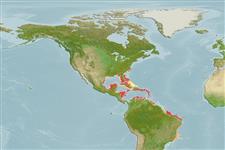Common names from other countries
Classification / Names / Names
Namen | Synonyme | Catalog of Fishes (gen., sp.) | ITIS | CoL | WoRMS
Environment: milieu / climate zone / depth range / distribution range
Ökologie
Riff-verbunden; tiefenbereich 0 - 80 m (Ref. 116065). Tropical
Western Atlantic.
Length at first maturity / Size / Gewicht / Alter
Maturity: Lm ? range ? - ? cm
Maximum depth from Ref. 128823. This is a solitary species (Ref. 128823). Found on coral debris on the sea floor (Ref. 415); in relatively deep water in coral reefs, common in shallow water, grows on hanging mangrove roots and directly on the peat bank (Ref. 1758).
Life cycle and mating behavior
Geschlechtsreife | Fortpflanzung | Ablaichen | Eier | Fecundity | Larven
Members of the class Ascidiacea are hermaphroditic; both cross- and self-fertilization is typical. Life cycle: Eggs develop into lecithotrophic larva before metamorphosing into benthic adults.
Collin, R., M.C. Díaz, J. Norenburg, R.M. Rocha, J.A. Sánchez, M. Schulze, A. Schwartz and A. Valdés. 2005. (Ref. 415)
IUCN Rote Liste Status (Ref. 130435)
CITES Status (Ref. 108899)
Not Evaluated
Not Evaluated
Nutzung durch Menschen
| FishSource |
Tools
Mehr Information
Alter/GrößeWachstumLänge-GewichtLänge-LängeMorphologieLarvenDichte
Internet Quellen
Estimates based on models
Preferred temperature
(Ref.
115969): 23.7 - 28.2, mean 27.4 (based on 544 cells).
Preiskategorie
Unknown.
